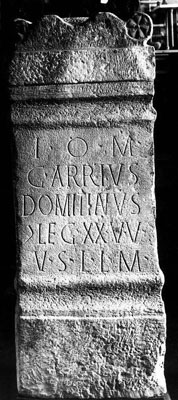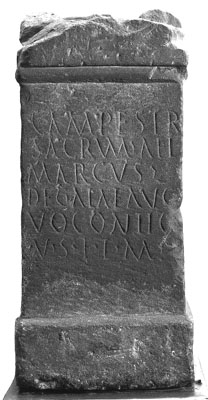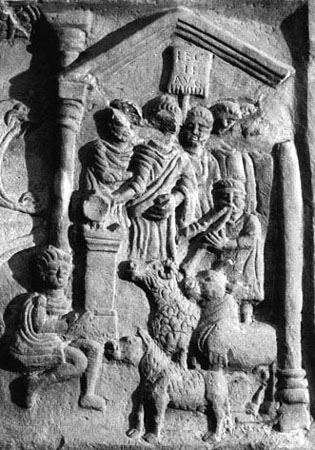The Romans conceived religion as a contract between themselves and the gods, who had to be propitiated. They believed that Roman power sprang from, and was maintained by, Roman piety. Jupiter, as Rome’s special protector, took precedence over all. His spiked thunderbolts were emblazoned on the soldiers’ shields and his war-bird, the eagle, marched with the legions as a silver image mounted on a pole. To lose this sacred emblem was the ultimate disgrace.

Roman standard-bearers march out on campaign:
a scene from Trajan's Column. The legion's eagle, borne by an aquilifer,
is at the centre. Other standards display portait medallions of the
emperor and his predecessors, while a vexillium, or flag, probably
proclaims the unit's titles.
© Author's collection
Each year vows to Jupiter were renewed at every fort, and fresh altars
dedicated. The old ones were reverently buried. An example (below left)
comes from Newstead, and probably dates to the Antonine reoccupation of
the fort in the 140s. IOM stands for Iovi Optimo Maximo - Jupiter
Best and Greatest. Gaius Arrius Domitianus, a centurion of the Twentieth
Valeria Victrix Legion, is the dedicator. The final letters V.S.L.L.M.
indicate that Gaius has “gladly, willingly, and deservedly fulfilled
his vow.”



© SCRAN/National Museums of Scotland
© SCRAN/National Museums of Scotland
© SCRAN/National Museums of Scotland
Gaius dedicated two other altars at Newstead. Both are to deities of the
wilds - Silvanus, a god of the woods, and Diana, the goddess of hunting.
It would be natural for Roman troops, reoccupying a long-abandoned fort
site, to propitiate the deities who might haunt it. Of particular interest
is the dedication to Silvanus, which is made not only for the welfare
of Gaius himself but also that of his family.
Altars to Jupiter, along with images and dedications to the emperor, were kept in a fort’s headquarters building, or principia, where they provided a focus of power and loyalty. Here the commanding officer presided over religious ceremonies such as the suovetaurilia, which involved the sacrifice of a bull, a boar, and a ram. Augury was also conducted in this sacred area. This was not concerned with the prediction of future events, but with obtaining through favourable signs, or auspices, divine approval for intended actions. The emperor was the chief augur, for he was considered to have a special link to the gods. His subordinates could therefore only carry out augury on his behalf, or “under his auspices”.
In
this scene from the Bridgeness Slab the commander of the Second Augusta
Legion pours a libation on an altar in preparation for the suovetaurilia.
This powerful ceremony of purification was conducted at the start or conclusion
of major enterprises such as the building of the Antonine Wall.
© SCRAN/National Museums of Scotland

The Romans believed in a parallel spirit world which touched every aspect
of nature and human affairs. It encompassed universal deities like Jupiter
down to godlings who might inhabit a particular tree or cupboard. Abstract
concepts such as victory, discipline, concord, or good luck were also
presided over by their special gods. It was therefore in everyone's best
interest to recognise and propitiate the deities relevant to any situation.
Sometimes this involved the building of temples, but the gods could be
anywhere. At all costs they were not to be offended, and with luck they
might even grant mortals their support and approval.
A tombstone found near the Antonine Wall fort at Mumrills illustrates
the universality of the Roman army and its religion. The inscription translates:
“To the Divine Shades. Here lies Nectovelius, son of Vindex. Aged thirty, and a Brigantian by birth, he served for nine years in the Second Thracian Cohort.”
Nectovelius was a native Briton, born into
the great Brigantian tribe which inhabited the area now covered by northern
England and parts of south-west Scotland. He joined the Roman army as
an auxiliary at the age of 21, and ended his service on the Antonine Wall.
In his short life he must have encountered the Celtic deities of his homeland,
the Hellenistic gods of his regiment, and the great protectors of the
Roman state. After nine years of service on the frontier Nectovelius earned
a Roman burial with full military honours.